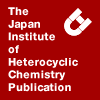

HETEROCYCLES
An International Journal for Reviews and Communications in Heterocyclic ChemistryWeb Edition ISSN: 1881-0942
Published online by The Japan Institute of Heterocyclic Chemistry
Regular Issue
Vol. 57, No. 11, 2002
Published online:
■ Structures and Radical Scavenging Activities of Novel Norstilbene Dimer, Longusone A, and New Stilbene Dimers, Longusols A, B, and C, from Egyptian Herbal Medicine Cyperus longus
Toshio Morikawa, Fengming Xu, Hisashi Matsuda, and Masayuki Yoshikawa*
*Kyoto Pharmaceutical University, Kyoto Pharmaceutical University
Abstract
The methanolic extract of the whole plant of Cyperus longus originating in Egypt was found to show scavenging activity for DPPH radical. By bioassay–guided separation, a nor-stilbene dimer, longusone A, with a tropilene structure and three stilbene dimers, longusols A, B, and C, were isolated as the active constituents together with 10 phenolic compounds. The structures of new compounds were elucidated on the basis of chemical and physicochemical evidence.
Published online:
■ A New Simple Method for the Synthesis of Thiophene Derivatives — Generation of Thiocarbonyl Ylides form S-α-(Dimethylphenylsilyl)benzyl Acylates and Their Cycloaddition with Acetylenic Dipolarophiles —
Mitsuo Komatsu,* Jinil Choi, Masatoshi Mihara, Yoji Oderaotoshi, and Satoshi Minakata
*Department of Applied Chemistry, Graduate School of Science, Osaka University, 2-1 Yamadaoka, Suita, Osaka 560-0871, Japan
Abstract
The cycloaddition of S-α-(dimethylphenylsilyl)benzyl acylates (1) with acetylenic dipolarophiles via 1,4-silatropy proceeded readily to afford thiophene derivatives. The reaction of thioesters (1) with 1-diethylamino-1- propyne (A), an electron-rich acetylenic dipolarophile, gave 5-aryl-3- diethylamino-4-methyl-2-phenylthiophenes (3) and 4-aryl-2-diethylamino- 3-methyl-5-phenylthiophenes (4). When dimethyl acetylenedicarboxylate (DMAD), an electron-deficient alkyne, was used, the reaction of thioesters (1) afforded thiophene derivatives (4) exclusively.
Published online:
■ A New Synthesis of Substituted 2,5-Dihydrobenzo[b]oxepines
Eng-Chi Wang,* Ming-Kun Hsu, Yu-Li Lin, and Keng-Shiang Huang
*School of Chemistry, aohsiung Medical University, 100 Shin Chuen 1st Rd., Kaohsiung 80708, Taiwan, R.O.C.
Abstract
Based on Claisen rearrangement, Baeyer-Villiger oxidation, and ring-closing metathesis (RCM), a series of substituted 2,5-dihydrobenzo[b]oxepines were synthesized from isovanillin in good over-all yields. Other appropriate substituted 2,5-dihydrobenzo[b]oxepines prepared from corresponding phenol derivatives were also described.
Published online:
■ Crystal and Molecular Structures of Racemic and Chiral 4-Phenyl-1,3-thiazolidine-2-thione
Ko-Ki Kunimoto,* Soh-ichi Kitoh, Masaki Ichitani, Norio Funaki, Akio Kuwae, and Kazuhiko Hanai
*Department of Chemistry and Chemical Engineering, Faculty of Technology, Kanazawa University, Kakumamachi, Kanazawa 920-1192, Japan
Abstract
The crystal and molecular structures of (rac)- and (S)-4-phenyl-1,3-thiazolidine-2-thiones (4-PTT) have been studied by X-Ray diffraction and ab initio MO calculations at the level of HF/6-31G*. In racemic crystals, the thioamide groups of the enantiomeric (R)- and (S)-4-PTT pairs are hydrogen-bonded around a crystallographic center of symmetry to form a planar cyclic dimer. On the other hand, in (S)-4-PTT crystals, a cyclic dimer through the hydrogen bonding is formed between the two independent molecules (molecules A and B) in the asymmetric unit and its geometry is distorted.
Published online:
■ A Synthesis of Substituted 3,6-Dihydro-1H-benzo[c]oxocines via Claisen Rearrangement and Ring-closing Metathesis
Eng-Chi Wang,* Chin-Cheng Wang, Ming-Kun Hsu, and Keng-Shiang Huang
*School of Chemistry, Kaohsiung Medical University, 100 Shin Chuen 1st Rd., Kaohsiung 80708, Taiwan, R.O.C.
Abstract
Started from isovanillin, based on Claisen rearrangement and ring-closing metathesis (RCM) reaction, a series of substituted 3,6-dihydro- 1H-benzo[c]oxocines were synthesized in moderate yields.
Published online:
■ The Preparation of the Stable Tautomers of 4-Mercapto-3-quinolinesulfonic and 1,4-Dihydro-4-thioxo-3-quinolinesulfonic Acids
Leszek Skrzypek* and Kinga Suwinska
*Department of Organic Chemistry, The Medical University of Silesia, Jagiellonska Str. 4, 41-200 Sosnowiec, Poland
Abstract
The reaction of 4-chloro-3-quinolinesulfonic acid (3) with sodium hydrosulfide gives the sodium salt of 1,4-dihydro-4-thioxo-3-quinolinesulfonic acid (4) and 4-mercapto-3-quinolinesulfonic acid (4b). The acidification of aqueous solution of the sodium salt of 4 results in 1,4-dihydro-4-thioxo-3-quinolinesulfonic acid (4a). It has been found that in the DMSO solution tautomer (4a) converts into tautomer (4b). The X-Ray analysis of tautomer (4a) indicates that it appeared in a form of betaine (4c).
Published online:
■ Synthesis and Reactivity of (Z)-3-Benzoylamino-4-dimethylamino-2-oxo-3-butene. Preparation of 1-Aryl- and 1-Heteroaryl-substituted 4-Benzoyl-amino-5-methyl-1H-pyrazoles
Urska Bratusek, Simon Recnik, Jurij Svete,* Ljubo Golic, and Branko Stanovnik*
*Faculty of Chemistry and Chemical Technology, University of Ljubljana, Askerceva 5, P.O. Box 537, SLO-1000 Ljubljana, Slovenia
Abstract
(Z)-3-Benzoylamino-4-dimethylamino-2-oxo-3-butene (4), prepared from 1-benzoylamino-2-propanone (3) and N,N-dimethylformamide dimethyl acetal, was converted regioselectively by reaction with a series of hydrazines (5) into 1-substituted 4-benzoylamino-5-methyl-1H-pyrazoles (8). Reactions of 4 with primary amines (10) and with dimethylbarbituric acid (12) afforded the dimethylamine substitution products (11) and (13), respectively. Treatment of the butenone (13) with ammonia furnished tetrahydropyrido[2,3—d]pyrimidine derivative (14).
Published online:
■ Photocycloaddition of 1,3-Diphenyl-N-methyl Enaminoketonatoboron Difluoride with Simple Olefins
Kuniaki Itoh,* Kazuhiko Okazaki, and Yoshito Toyotomi
*Department of Chemistry, Faculty of Science, Kobe University, Nada-Ku, Kobe 6557-8501, Japan
Abstract
The photoaddition of some cyclic and acyclic olefins to (N-B)-Z-1-difluoroboryloxy-1,3-diphenyl-3-methylimino-1-propene (BF2-complex (1)) is discussed. Some of the resulting [2+2] photoadducts produce cyclobutane derivatives having cis configurations. The rearrangements of the cyclobutanes give pyridinium salts and 1,5-diketones. Reaction schemes for the formation of the cyclobutanes are presented. The dimer of the BF2-complex (1) is also formed in a reaction which is in competition with the olefins photoaddition.
Published online:
■ A New Synthesis of 6-Substitiuted Pyrido[2,3-d]pyrimidines
Takeshi Kuwada, Kenichi Harada, Junko Nobuhiro, Tominari Choshi, and Satoshi Hibino*
*Graduate School of Pharmacy and Pharmaceutical Sciences, Faculty of Pharmacy and Pharmaceutical Sciences, Fukuyama University, Fukuyama, Hiroshima 729-0292, Japan
Abstract
The reaction of the β-methylsulfanylacroleins, derived from alkenyl sulfides by the Vilsmeier reaction, with 6-aminouracils or 2,6-diaminouracil, provides a new synthetic route to the 6-substituted pyrido[2,3-d]pyrimidines by two methods, the reaction mechanisms of which were examined by a deuterium-labeled thioacrolein.
Published online:
■ Coupling of Heteroaryldiazonium Tetrafluoroborates with 1,3-Dicarbonyl Compounds—regioselective Synthesis of Alkyl 1-Heteroaryl-4-hydroxy-1H-pyrazole-3-carboxylates
Simon Recnik, Jurij Svete,* and Branko Stanovnik
*Faculty of Chemistry and Chemical Technology, University of Ljubljana, Askerceva 5, P.O. Box 537, SLO-1000 Ljubljana, Slovenia
Abstract
Coupling of 1-cyano-4-oxo-4H-quinolizine- (2), 1-ethoxycarbonyl-4-oxo-4H-quinolizine- (3), and 4-oxo-4H-pyridino[1,2—b]pyrimidine-3-diazonium tetrafluoroborates (4) with 1,3-dicarbonyl compounds (1a—i) afforded the corresponding hydrazones (5—7) in 55—96% yields. The orientation around the C=N double bond in unsymmetrically substituted hydrazones (7a,c) was determined by NMR (NOESY) spectrometry. Heating of hydrazones (5a,b—7a,b), derived from alkyl 4-chloro-3-oxobutanoates (1a,b), furnished 1-(1-substituted quinolizin-3-yl)- (8, 9) and 1-(pyridino[1,2—a]-pyrimidin-3-yl)-4-hydroxy-1H-pyrazole-3-carboxylates (10) in 87—96% yields.
Published online:
■ Synthesis of Tropocryptands Having Heteroatoms in Linker Chains: A New Class of Macrobicyclic Ligands Derived by N-Acylation and N-Alkylation of Tropocoronand
Ohki Sato, Yutaka Ono, and Josuke Tsunetsugu*
*Department of Chemistry, Faculty of Science, Saitama University, Saitama, Saitama 338-8570, Japan
Abstract
Tropocoronand (1) reacted with acyl chlorides on endocyclic secondary alkylamines to afford diacyl tropocoronands (2a — 2c). Double N-acylation of 1 with dioyl dichlorides (3a — 3d) yielded amide-bridged tropocryptands (4a — 4d). The similar reactions of 1 with ethylene glycol di-p-tosylate (5) or oligo(ethylene glycol) di-p-tosylate (8a — 8d) afforded the corresponding tropocryptands (6 or 9a — 9d).
Published online:
■ Study of the Reactivity of 5-Alkynyl-4-chloro- and 4-Alkynyl-5-chloropyridazin-3(2H)-ones towards Oxygen and Sulfur Nucleophiles
Omar R’kyek, Bert U. W. Maes, Guy L. F. Lemière,* and Roger A. Dommisse
*Department of Chemistry, University of Antwerp (RUCA), Groenenborgerlaan 171, B-2020 Antwerp, Belgium
Abstract
A study of the reactivity of 5-alkynyl-4-chloro- (1a,b) and 4-alkynyl-5-chloropyridazin-3(2H)-ones (4a,b) towards oxygen and sulfur nucleophiles (NaOCH3, NaSCH3, KOH and Na2S) is reported. The synthesis of 5-alkynyl-2-methyl-4-methoxy- (2a,b) and 5-alkynyl-2-methyl-4-methylthiopyridazin-3(2H)-ones (3a,b) and their regioisomers 4-alkynyl-2-methyl-5-methoxy- (5a,b) and 4-alkynyl-2-methyl-5-methylthiopyridazin-3(2H)-ones (6a,b) is described, as well as the synthesis of 2-substituted 6-methylfuro[2,3-d]- (7a,b,c) and 2-substituted 6-methylthieno[2,3-d]pyridazin-7(6H)-ones (8a,b) and their regioisomers 2-substituted 5-methylfuro[2,3-d]- (9a,b,c) and 2-substituted 5-methylthieno[2,3-d]pyridazin-4(5H)-ones (10a,b).
Published online:
■ Allenyl(vinyl)methane Photochemistry. Photochemistry of 2-(3,4-Pentadienylidene)indan-1,3-dione Derivatives
Takashi Tsuno* and Kunio Sugiyama
*Department of Applied Molecular Chemistry, College of Industrial Technology, Nihon University, 1-2-1, Izumi-cho, Narashino, Chiba 275-8575, Japan
Abstract
2-(3,4-Pentadienylidene)indan-1,3-dione derivatives underwent the photochemical intramolecular oxa-Diels-Alder reaction to produce pyrans. The oxa-Diels-Alder reaction proceeded via the singlet-excited state.
Published online:
■ New Tabernamine Derivatives from Tabernaemontana
Toh-Seok Kam* and Kooi-Mow Sim
*Department of Chemistry, Unviersity of Malaya, Pantai Valley, 50603 Kuala Lumpur, Malaysia
Abstract
Three new bisindole alkaloids of the vobasine-iboga type, which are derivatives of tabernamine, viz., 19’(S)-hydroxytabernamine, 19’(R)-hydroxy-tabernamine, and 19‘-oxotabernamine, were isolated from the stem-bark extract of Tabernaemontana corymbosa and the structures were established by spectroscopic analysis.
Published online:
■ High-Throughput Synthesis of Symmetrically 3,5-Disubstituted 4-Amino-1,2,4-triazoles from Aldehydes Using Microwave
Hideko Koshima,* Mitsuo Hamada, Makiko Tani, Shunsuke Iwasaki, and Fumika Sato
*Department of Applied Chemistry, Faculty of Engineering, Ehime University, 3 Bunkyo-cho, Matsuyama, 790-8577 Ehime, Japan
Abstract
Symmetrically 3,5-substituted 4-amino-1,2,4-triazoles are quickly prepared from aromatic aldehydes via nitriles by two-step reactions without any separation under microwave irradiation for each several minutes.
Published online:
■ Bischler-Napieralski Reaction of N-[2-(2-Bromo-4,5-dialkyloxyphenyl)ethyl]-N-(1-phenylethyl)-2-(2-bromo-4,5-dimethoxyphenyl)acetamides
Naomi Hashimoto, Kumiko Miyatani, Keiko Ohkita, Yoshitaka Ohishi,* Jun-ichi Kunitomo, Ikuo Kawasaki, Masayuki Yamashita, and Shunsaku Ohta
*Faculty of Pharmaceutical Science, Mukogawa-Women‘s University, 11-68 Koushien Kyuban-Cho, Nishinomiya, Hyogo 663-8179, Japan
Abstract
Direction of Bischler-Napieralski reaction of N-[2-(2-bromo- or 2-unsubstituted 4,5-dialkoxyphenyl)ethyl]-N-(1-phenylethyl)-2-(2-bromo-4,5-dimethoxyphenyl)acetamides is discussed.
Published online:
■ Hantzsch Dihydropyridine: An Effective and Convenient Regioselective Reducing Agent for the 5-Benzylidene-2,4-thiazolidinedione Derivatives
Hong Woo Lee,* Bok Young Kim, Joong Bok Ahn, Hoe Joo Son, Jae Wook Lee, Soon Kil Ahn, and Chung Il Hong
*Chemical Process Development Laboratories, Chong Kun Dang Research Institute, Chonan P.O. Box 74, Chonan, 330-831, Korea
Abstract
An effective and convenient regioselective reduction of 5-benzylidene 2,4-thiazolidinedione derivatives to the corresponding 5-benzyl 2,4-thiazolidinedione derivatives has been accomplished using 3,5-dicarbethoxy-2,6-dimethyl-1,4-dihydropyridine (Hantzsch dihydropyridine ester : HEH) with silica gel as an acid catalyst in a good yield.
Published online:
■ A Novel Flvonol Glucoside from Onion
Miyuki Furusawa, Toshiyuki Tanaka,* Ken-ichi Nakaya, Munekazu Iinuma, and Hironori Tuchiya
*Gifu Prefectrual Institute of Health and Environmental Sciences, 1-1 Nakafudogaoka, Kakamigahara, Gifu 504-0838, Japan
Abstract
A new flavonol glucoside was isolated from the outer bulb of onions (Allium cepa). The structure was determined by the analysis of spectral data.
Published online:
■ Cavitands and Related Container Molecules
Wanda Sliwa,* Grazyna Matusiak, and Malgorzata Deska
*Institute of Chemistry and Environmental Protection, Pedagogical University, Al. Armii Krajowej 13/15, 42-201 Czestochowa, Poland
Abstract
The chemistry of cavitands and container molecules, so covalently as noncovalently linked, is reviewed. Synthetic approaches and complexing properties of some of the above species are described.